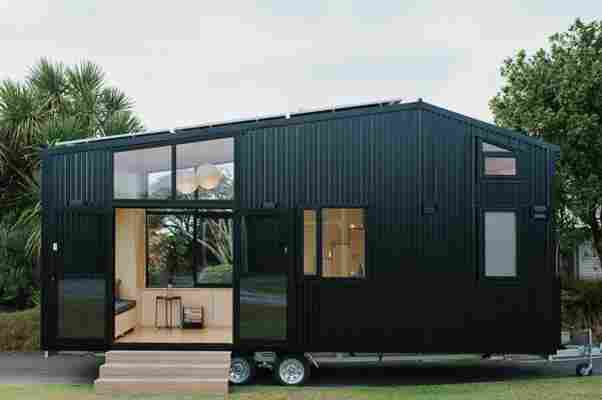
Transportable tiny homes are complex operations, to say the least. Designing them to be sustainable makes building them that much more of an intricate process. First Light Studio, a New Zealand-based architecture group built their own tiny home with help from a local company Build Tiny, Ohariu, checking all of the above boxes. Built to be net-zero through several sustainable features and compact enough to meet all NZTA regulations for mobile homes.
Ohariu was built by First Light Studio and Build Tiny from a client’s brief calling for, “a refined tramping lodge on wheels.” That’s code for hiking, for all us Americans. Since the tiny home would primarily be used for hiking trips and traveling throughout the outdoors, Ohariu was built to be adaptable and versatile above all else. Inside, the living spaces are described by the architects at First Light Studio as being, “more a large and very detailed piece of furniture than a traditional house build, the fit-out [focusing] on the things that are important and necessary.”
Catering to the necessities and casual family pastimes, the tiny home is doused in modular and multifunctional design that’s surrounded by creamy poplar plywood walls and silvery fittings that add a touch of refinement to an otherwise bare interior. Each furniture piece inside Ohariu doubles as storage to maintain an open, clutter-free interior where the tiny home’s family would bond over pastimes like cooking, playing card games, and enjoying the surrounding landscape. Featuring a chef’s kitchen, Ohariu comes with plenty of prep space for cooking and integrates tilt-up tabletops to make even more for when there’s company. Outside, Ohariu is coated in a stealthy ebony corrugate to match its lightweight mobility, supported by aluminum joinery, lights, and utilities that were given the same ebony finish. Ohariu’s roof is asymmetrical with six solar panels lined up on its longer side and a mezzanine bedroom cozying up beneath its sloped short side.
Entirely powered by the solar panels that make a grid on the roof, Ohariu is net-zero, featuring amenities like an LPG gas cylinder, LED lighting, low-water usage fittings, as well as a composting toilet. Enhancing the tiny home’s sustainable build, the materials used to construct Ohariu are recyclable for the most part and low-maintenance, durable, and locally sourced.
Designer: First Light Studio x Build Tiny
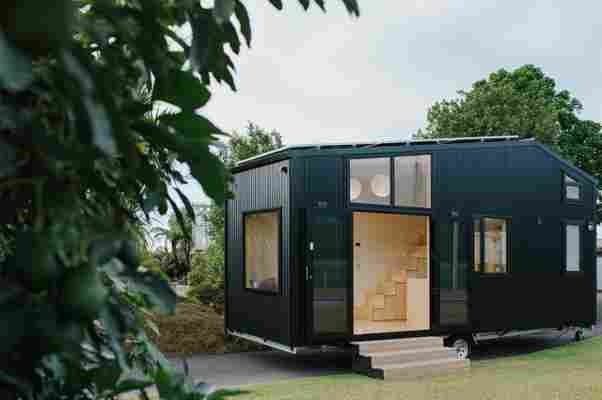
Ohariu features expansive french doors, opening up the interior to the outside environment for endless views while traveling.
Coated in ebony corrugate, Ohariu travels from one excursion to the next, never losing its stealthy personality.
With plenty of open interior space, when the french doors open up, the interior seamlessly blends with the outside.
Poplar plywood line the walls and furniture of Ohariu’s interior living spaces for bright, sunlight-drenched room.
The chef’s kitchen features plenty of integrated storage and even a tilt-up tabletop to make more room for kitchen prep.
The mezzanine bedroom is located near the roof’s pitched, shorter side.
Plenty of broad windows line the sides of Ohariu to really brighten the space.
The world’s first 8-feet artificial wave generating pool to safely up your surfing game!
{"title":"World's largest concentric waves pool","author_name":"Yanko Design","author_url":"https://www.youtubeom/channel/UCVohuIZpji5uTdzychBxKcw","type":"video","height":"591","width":"1050","version":"1.0","provider_name":"YouTube","provider_url":"https://www.youtubeom/","thumbnail_height":"360","thumbnail_width":"480","thumbnail_url":"https://i.ytimgom/vi/O0iwNvfwbiw/hqdefault.jpg","html":"<iframe width="1050" height="591" src="https://www.youtubeom/embed/O0iwNvfwbiw?feature=oembed" frameborder="0" allow="accelerometer; autoplay; clipboard-write; encrypted-media; gyroscope; picture-in-picture" allowfullscreen></iframe>","arve_cachetime":"2021-03-05 09:11:27","arve_url":"https://youtu.be/O0iwNvfwbiw","arve_srcset":"https://i.ytimgom/vi/O0iwNvfwbiw/mqdefault.jpg 320w, https://i.ytimgom/vi/O0iwNvfwbiw/hqdefault.jpg 480w, https://i.ytimgom/vi/O0iwNvfwbiw/sddefault.jpg 640w, https://i.ytimgom/vi/O0iwNvfwbiw/maxresdefault.jpg 1280w"}
Feeling like hitting the waves? We don’t know when beaches will open but this controlled wave pool in Australia will be able to provide some relief to surfers while still being able to manage the crowds by keeping it to the recommended number of people as per social distancing guidelines. The interesting feature of this wave pool is that the generator creates waves in concentric circles that then radiate outwards. The idea for these concentric waves was conceived when Founder and CEO, Aaron Trevis, was tossing rocks into a lake with his children.
Surf Lakes is the world’s largest controlled wave pool famous for offering five different types of waves to their surfers! The pool generates 2000 waves per hour (so your week’s cardio is complete) thanks to the 5 Waves technology. It provides a safe space for surfers of all skill levels to practice and enjoy like they would in the ocean. It is as close to the real thing as you can get, the technology mimics the natural ocean groundswells resulting in waves that break over specially crafted reefs in sets of two or six per swell. Each pulse from the central generator can create 10 waves. To mimic the natural environment closely, each reef is distinctively shaped which allows the wave to crash and dissipate differently in terms of speeds, shapes, and sizes.
It has been the only facility to be able to generate an 8-feet tall wave artificially. The five different levels of waves all vary in difficulty, size, and length and are color-coded so beginner surfers through to moderate and advanced surfers can enjoy wave riding. Surf Lakes is working on making this technology available worldwide so that we can ride out this transition into the new normal!
Designer: Surf Lakes
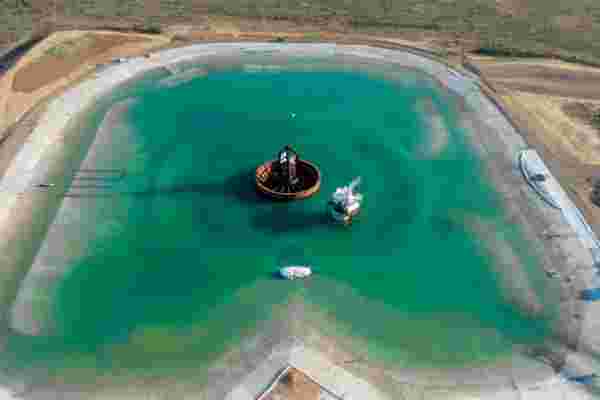
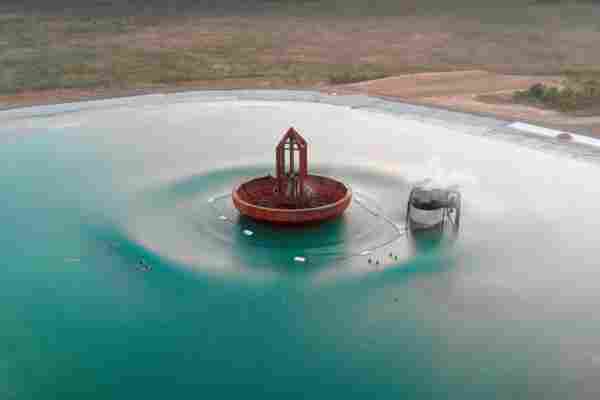
{"title":"Former World Surf Champion Barton Lynch explains 5Waves","author_name":"Yanko Design","author_url":"https://www.youtubeom/channel/UCVohuIZpji5uTdzychBxKcw","type":"video","height":"591","width":"1050","version":"1.0","provider_name":"YouTube","provider_url":"https://www.youtubeom/","thumbnail_height":"360","thumbnail_width":"480","thumbnail_url":"https://i.ytimgom/vi/-jFrhlfnJzw/hqdefault.jpg","html":"<iframe width="1050" height="591" src="https://www.youtubeom/embed/-jFrhlfnJzw?feature=oembed" frameborder="0" allow="accelerometer; autoplay; clipboard-write; encrypted-media; gyroscope; picture-in-picture" allowfullscreen></iframe>","arve_cachetime":"2021-03-05 09:11:27","arve_url":"https://youtu.be/-jFrhlfnJzw","arve_srcset":"https://i.ytimgom/vi/-jFrhlfnJzw/mqdefault.jpg 320w, https://i.ytimgom/vi/-jFrhlfnJzw/hqdefault.jpg 480w, https://i.ytimgom/vi/-jFrhlfnJzw/sddefault.jpg 640w, https://i.ytimgom/vi/-jFrhlfnJzw/maxresdefault.jpg 1280w"}
World’s first 3D-printed stainless steel bridge links Amsterdam’s past and future in its red-light district!
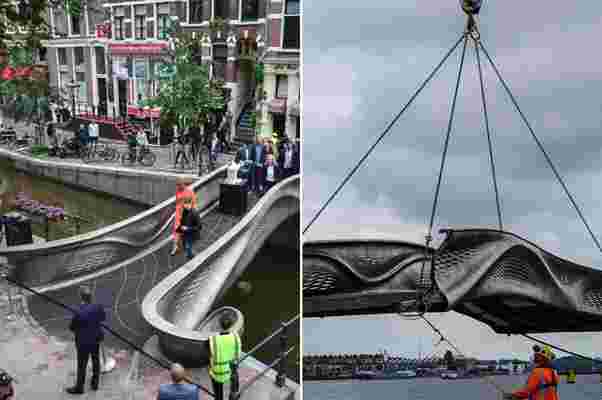
Amsterdam is known for its calm canals and winding alleyways, its rich cultural history, and its affinity for all kinds of pleasure. Historical landmarks still charm tourists and residents alike between the city’s canals, while contemporary and sustainable architecture put the burgeoning Amsterdam-Noord borough back on the map. Linking Amsterdam’s past with its future, designers and engineers at MX3D and Joris Laarman Lab developed the world’s first 3D printed bridge over one of Amsterdam’s oldest canals in De Wallen, the city’s red-light district.
MX3D and Joris Laarman Lab collaborated with global engineering firm Arup along with a host of designers and 3D-print teams to develop the robot-welded bridge. Welding traditional steelwork with computational design, the stainless steel bridge symbolizes a linking of Amsterdam’s past with its future. Stretching just over twelve meters in length, MX3D equipped simple, technical robots with purpose-built tools that were controlled by integrated software that the team of designers developed over the span of two years.
Arup, the project’s lead structural engineer, practiced advanced parametric design modeling to streamline the bridge’s preliminary design process. Describing the developmental stages and inspiration behind building the bridge, MX3D notes, “The unique approach allows us to 3D print strong, complex and graceful structures out of metal. The goal of the MX3D Bridge project is to showcase the potential applications of our multi-axis 3D printing technology.”
Currently open to the public, the bridge was unveiled by Her Majesty Queen Máxima of the Netherlands. Ushering in a strengthened bond between the possibilities of modern technology and a reverence for the city’s architectural integrity, the new bridge in Amsterdam’s red-light district stands as a link between the past and the future.
Designers: MX3D , Joris Laarman Lab , & Arup
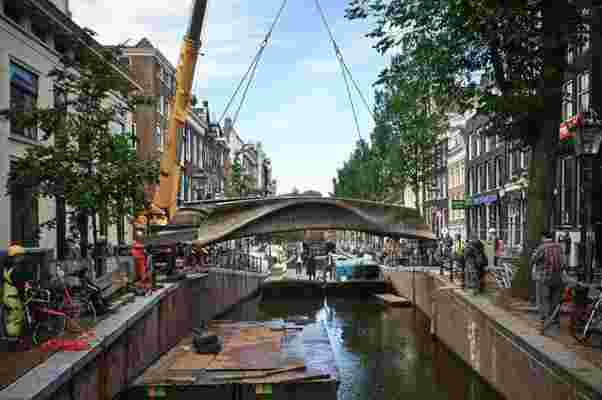
Using advanced parametric design modeling to streamline the bridge’s initial design process, engineers programmed software to control the 3D printer’s construction and direction.
Amsterdam’s 3D printed bridge merges classical architecture with modern technology.
Constructed offsite, the bridge was transported on a boat to its final destination.
Weaving through Amsterdam’s canals, the bridge was ultimately brought to its final destination in the red-light district.
Her Majesty Queen Máxima of the Netherlands unveiled the project’s debut in ode to Amsterdam’s rich cultural history.








